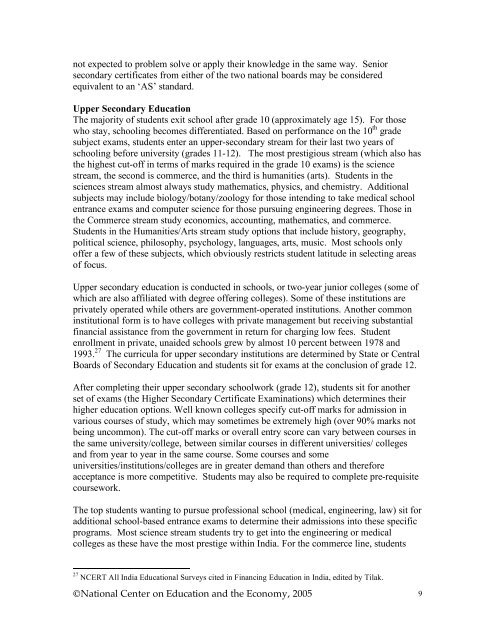India Education Report (2005) - NCEE
India Education Report (2005) - NCEE
India Education Report (2005) - NCEE
You also want an ePaper? Increase the reach of your titles
YUMPU automatically turns print PDFs into web optimized ePapers that Google loves.
not expected to problem solve or apply their knowledge in the same way. Senior<br />
secondary certificates from either of the two national boards may be considered<br />
equivalent to an ‘AS’ standard.<br />
Upper Secondary <strong>Education</strong><br />
The majority of students exit school after grade 10 (approximately age 15). For those<br />
who stay, schooling becomes differentiated. Based on performance on the 10 th grade<br />
subject exams, students enter an upper-secondary stream for their last two years of<br />
schooling before university (grades 11-12). The most prestigious stream (which also has<br />
the highest cut-off in terms of marks required in the grade 10 exams) is the science<br />
stream, the second is commerce, and the third is humanities (arts). Students in the<br />
sciences stream almost always study mathematics, physics, and chemistry. Additional<br />
subjects may include biology/botany/zoology for those intending to take medical school<br />
entrance exams and computer science for those pursuing engineering degrees. Those in<br />
the Commerce stream study economics, accounting, mathematics, and commerce.<br />
Students in the Humanities/Arts stream study options that include history, geography,<br />
political science, philosophy, psychology, languages, arts, music. Most schools only<br />
offer a few of these subjects, which obviously restricts student latitude in selecting areas<br />
of focus.<br />
Upper secondary education is conducted in schools, or two-year junior colleges (some of<br />
which are also affiliated with degree offering colleges). Some of these institutions are<br />
privately operated while others are government-operated institutions. Another common<br />
institutional form is to have colleges with private management but receiving substantial<br />
financial assistance from the government in return for charging low fees. Student<br />
enrollment in private, unaided schools grew by almost 10 percent between 1978 and<br />
1993. 27 The curricula for upper secondary institutions are determined by State or Central<br />
Boards of Secondary <strong>Education</strong> and students sit for exams at the conclusion of grade 12.<br />
After completing their upper secondary schoolwork (grade 12), students sit for another<br />
set of exams (the Higher Secondary Certificate Examinations) which determines their<br />
higher education options. Well known colleges specify cut-off marks for admission in<br />
various courses of study, which may sometimes be extremely high (over 90% marks not<br />
being uncommon). The cut-off marks or overall entry score can vary between courses in<br />
the same university/college, between similar courses in different universities/ colleges<br />
and from year to year in the same course. Some courses and some<br />
universities/institutions/colleges are in greater demand than others and therefore<br />
acceptance is more competitive. Students may also be required to complete pre-requisite<br />
coursework.<br />
The top students wanting to pursue professional school (medical, engineering, law) sit for<br />
additional school-based entrance exams to determine their admissions into these specific<br />
programs. Most science stream students try to get into the engineering or medical<br />
colleges as these have the most prestige within <strong>India</strong>. For the commerce line, students<br />
27 NCERT All <strong>India</strong> <strong>Education</strong>al Surveys cited in Financing <strong>Education</strong> in <strong>India</strong>, edited by Tilak.<br />
©National Center on <strong>Education</strong> and the Economy, <strong>2005</strong> 9


